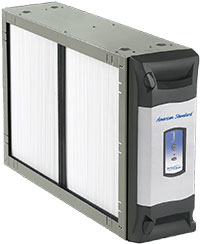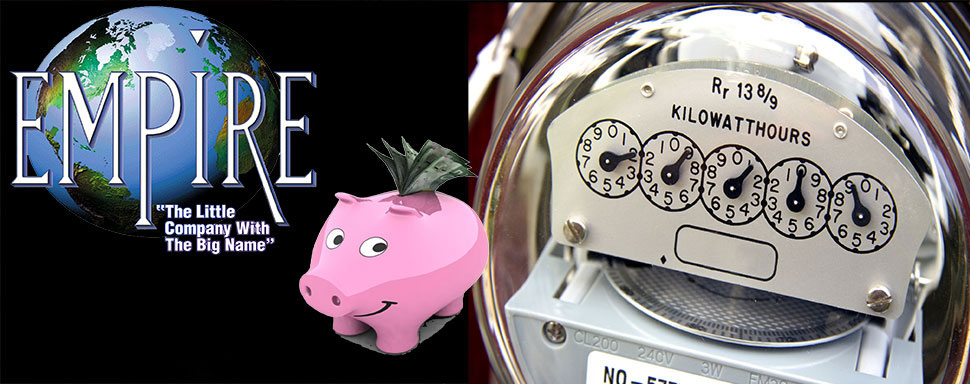
SEER - EER
SEER and EER are measurements of the number of output Btus related to the inputs watts of electricity used. The higher the SEER and EER the smaller your electrical bill will be. SEER stands for seasonal energy efficiency ratio and EER stands for energy efficiency ratio. The difference between the two is that SEER takes into account the cycling on and off (expected seasonal conditions) of the air conditioner rather than the steady on that EER does.
SEER is higher than EER and is expected to be done away with in the next few years. Adding the variables for expected usage added a layer of inaccuracies and assumptions that has led to false efficiencies being published. When first used it was thought that SEER would be a more accurate measurement for electricity use, but just the opposite has occurred. For the time being, SEER is still the standard.
HSPF
HSPF stands for heating seasonal performance factor and is generally used to measure the performance of heat pumps in the winter months. HSPF is a ratio of Btu heat output compared to the amount of electricity used in watts. The higher the HSPF the lower your electrical bill.
Effective Efficiency - Effecting SEER Rating
Effective efficiency is a lot about total system performance. The manufactures have convinced the public through advertising campaigns and through sponsored rebates and the “Green” movement that getting high efficiency in your heating and air conditioning system is about buying a box, a brand new gadget designed to use less electricity and less gas.
That can happen—about 10% of the time!
Installing a new HVAC system can certainly lower your electricity and gas bills. A new air conditioner versus one as little as 5 years old can reduce your electrical bills by 50% or more, but this is only a relationship and that is why we need to look at the entire system.
Let me paint you a picture
You are driving a 1973 Oldsmobile Cutlass with a 455 big block engine. You are getting about 5 miles to gallon. You watch a commercial on the “Green” channel that says the new Ford Fiesta gets 35 mpg city with a 5 speed transmission. Excellent, the savings each month in gas will pay for the upgrade. You take your Oldsmobile down to the Ford Dealership and have a new Fiesta engine and 5 speed transmission installed. Everything is peachy keen, or is it?
Do you really think that you are going to get better mpg?
This is exactly what has been going on in the air conditioning and heating industry for about 10 years. Unless you examine the entire system before installing a new system, you are bound to have the new system operates only a little better than the old system. It will cost a little less to operate, but it’s performance will be likely crippled by the same percentage of effective efficiency.
What is Effective Efficiency?
After taking measurements of your system we can calculate the percentage of loss performance (Btus) compared to what the manufacture stated it should put out. For instance; If your air conditioning system is a 5 Ton system at 85 degrees outdoors it is suppose to put out 60,000 Btus. If we calculate that you are only receiving 46,000 at 85 degrees your effective efficiency is 46,000 ÷ 60,000 or only 76.6% efficient. If that loss of efficiency is from something other than the equipment, many times it is, then replacing the equipment will yield a new system that operates at only 76.6% of it’s capacity, yet you will still be blessed with a full service electric bill.
What is Effective SEER?
This is simply your system effective efficiency multiplied by your factory SEER rating. In the above example lets say the new system installed is a 13 SEER with the old system being a 10 SEER. The new effective SEER would be 13 × 0.766 = 9.9 SEER. The next logical question is: What if we just made the minor repairs to the old 10 SEER system for a fraction of the cost of the new system? Wouldn’t we be achieving the same monthly cost savings in utility bills?
What if we made the correct changes to the system and replaced the system?
The old system started at a 10 SEER system and it has been operating at 76.6 effective air conditioning efficiency. That translates into an Effective SEER of 7.6. If we take 7.6 and divide that by the new air conditioner efficiency of 13 we come up with the ratio of 0.58. To project our electrical savings all we have to do is multiple that part of our electrical bill attributed to air conditioning usage by 0.58 to come up with our new bill. Doesn’t that mean that your new electrical bill will only be about 60% of your old one?
What if the New System SEER was 20?
(7.6 ÷ 20 ) x (old summertime electric bill) = (new summertime electric bill). This means that the new electric bill is only about 40% of the old electric bill. The average electric bill attributed to air conditioning is about $150 a month with a total of 4 months usage here in Southern California. The new bill would be about $60 a month and would save approximately $360 a year in air conditioning bills. Over a 10 year period at today's rates that means a savings of $3600. These are very conservative numbers and chances are very good that your savings will exceed these. If you have a large system(s) and you are in the upper tier rates of electrical billing your savings could easily triple this number.
Understanding the Power Company's Tier Rates
Understanding the Power Company's Tier Rates. Your central air conditioner may use 15,000 watts (15 kilowatts) of electricity per hour, costing about $1.80 per hour to run in Tier 1. Throughout the month, if you use your A/C often, your electricity usage will rise, and you may move into a higher price tier. Leave your air on all day and night one month, and your usage may spill into Tier 5, and the same air conditioner can cost you about $4.20 per hour to run. If your air conditioner isn't running correctly and it ran for 24 hours straight that one day of cooling could cost you $57.60.
How Do I Find Out What My Electric Bill Is for Air Conditioning?
Your electric company keeps your bills for a number of years and you have access to those bills. To find out the increase in electrical usage during the summer, simply take your electrical bill in a month you use your air conditioner, like August, and subtract an electrical bill in a month you don’t use your air conditioner, like March. This will be a close approximation of your usage, not some government projection based on average cooling hours. |




